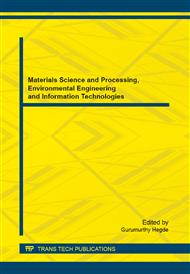p.296
p.300
p.307
p.311
p.315
p.319
p.323
p.327
p.331
P-Toluene Sulfonic Acid Doped Polyaniline/Carbon Nanotube Nanocomposites by a Sequential Doping-Dedoping-Redoping Process
Abstract:
HCl doped Polyaniline (PANI)/multi–walled carbon nanotube (MWCNT) nanocomposites were first prepared by in–situ chemical polymerization of aniline monomers in the presence of MWCNTs with less structural defects, and then p–toluene sulfonic acid (TSA) doped PANI/MWCNT nanocomposites were obtained by a sequential doping–dedoping–redoping process. The morphology, microstructure, and thermal and electrochemical properties of the resulting nanocomposites were investigated by scanning electron microscopy, fournier infrared spectroscopy, thermal gravimetric analysis, and cyclic voltammetry, respectively. The effects of TSA as the secondary dopant on the microstructure and electrochemical properties were discussed. The results indicated that a significant improvement in the thermal stability could be achieved, while good electrochemical behavior could be remained.
Info:
Periodical:
Pages:
315-318
Citation:
Online since:
October 2014
Authors:
Price:
Сopyright:
© 2014 Trans Tech Publications Ltd. All Rights Reserved
Share:
Citation:


